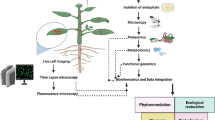Abstract
The short-term population dynamics of the culturable bacterial community from field-grown peanut (Arachis hypogeae L.) was analyzed over three 2-day periods. As in other phyllosphere studies, significant numbers of pigmented organisms were detected, suggesting the importance of pigmentation in the colonization of this habitat. Isolates were grouped according to pigmentation (orange, pink, yellow, nonpigmented), and the sensitivity of each isolate in the collection (n= 617) to ultraviolet radiation (UVR) was determined as the minimal inhibitory dose (MIDC) of UVR that resulted in an inhibition of growth compared to an unirradiated control. The majority of isolates recovered (56.1%) had an MIDC equal to or exceeding that of Pseudomonas syringae 8B48, a known UV-tolerant strain. Among pigmentation groups, the mean MIDC of pink- and orange-pigmented isolates was significantly greater than that of yellow- or nonpigmented isolates at each sampling time of day. Identification of 213 of the isolates using fatty acid methyl ester analysis indicated that a large proportion of the isolates were gram-positive, with Bacillus spp. alone accounting for 35.7% of the total. The genus Curtobacterium contained the largest percentage of highly UVR-tolerant strains. Nonpigmented mutants of four Curtobacterium strains were selected following ethyl methane sulfonate mutagenesis; these nonpigmented mutants were significantly altered in survival following irradiation with UV-A wavelengths. The strategy of avoidance of UVR through colonization of the abaxial leaf surface was evaluated on three separate occasions by leaf imprint sampling. Only 3 of 120 leaves (2.5%) contained larger bacterial populations on the adaxial surface, indicating that colonization of the abaxial leaf surface is important to phyllosphere survival. Our results indicate that tolerance to UVR is a common phenotype among phyllosphere bacteria, suggesting that solar radiation has a strong influence on the microbial ecology of the phyllosphere.
Similar content being viewed by others
Author information
Authors and Affiliations
Additional information
Received: 30 November 1998; Accepted: 9 March 1999
Rights and permissions
About this article
Cite this article
Sundin, G., Jacobs, J. Ultraviolet Radiation (UVR) Sensitivity Analysis and UVR Survival Strategies of a Bacterial Community from the Phyllosphere of Field-Grown Peanut (Arachis hypogeae L.). Microb Ecol 38, 27–38 (1999). https://doi.org/10.1007/s002489900152
Issue Date:
DOI: https://doi.org/10.1007/s002489900152




